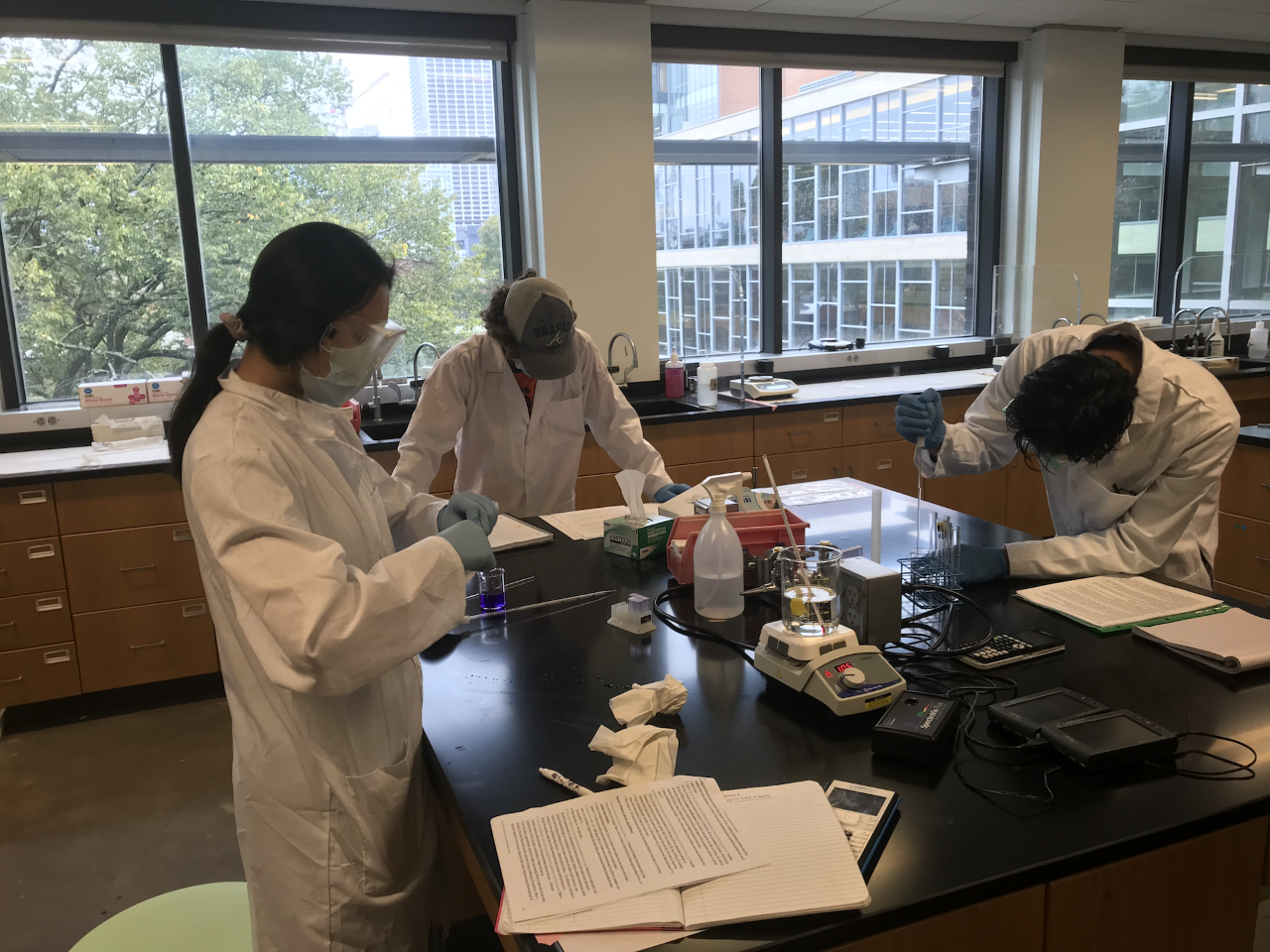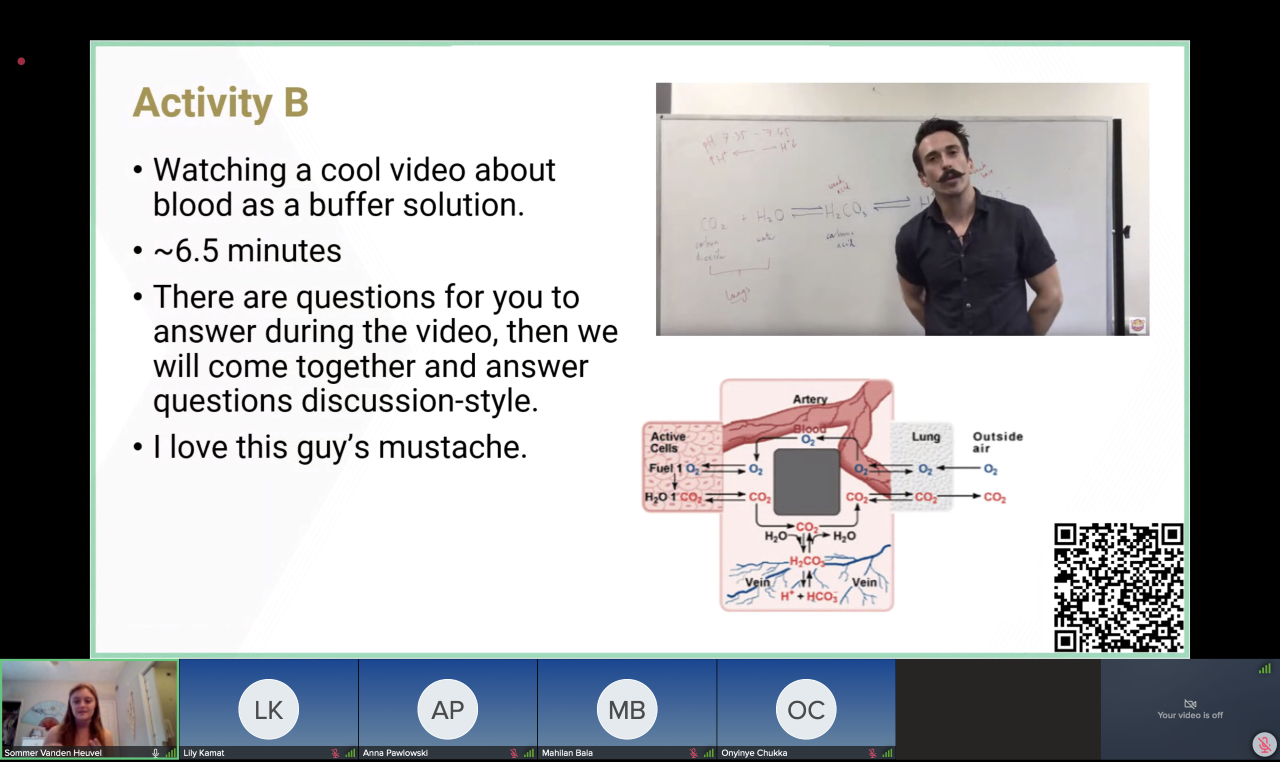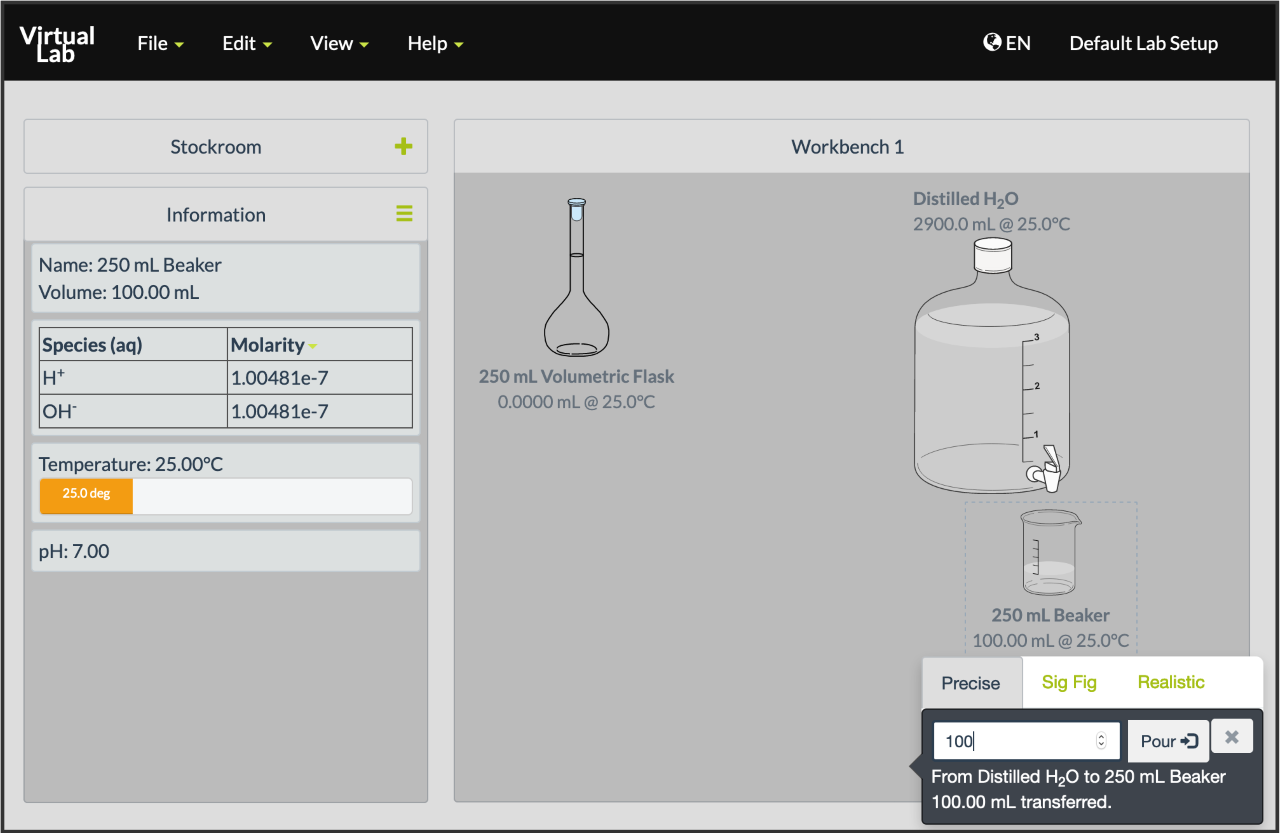
Dec 04, 2020 - Atlanta, GA
When classes unexpectedly transferred to an online format in March due to Covid-19, instruction had to quickly adapt to online norms. With little time to plan, teachers and students rapidly learned how to navigate BlueJeans and establish a new classroom routine.
Six months and nearly two full semesters later, faculty and students have fully adjusted to the online learning format with various modifications. In the School of Chemistry and Biochemistry, Michael Evans, Chemistry Laboratory Coordinator for first-year students, shares that “in emergency mode in the spring, I recorded myself performing experiments and supplied students with data.” Now, laboratories are conducted synchronously online or in a hybrid model, with socially distanced classes meeting every other week.
With lessons learned from the few weeks of online learning in the spring, Evans and colleagues Liz Jones, Head Teaching Assistant for first-year remote labs, and Carrie Shepler, Director of Instructional Activities and Student Experience, recognized that it was important for students to be actively engaged in a lab experiment, even if it is conducted via computer. Evans no longer records himself doing the lab experiment, but instead has students utilize online simulations through platforms such as Chem Collective to virtually conduct experiments.
“We wanted to do something where students would actually interact with things and also with each other,” says Jones, who did the majority of development of the synchronous online lab experiments for the summer session. “The labs are designed in a way where students will work in small groups, and go through two to three activities that are based predominately around some kind of simulation that’s online.”
In synchronous BlueJeans sessions, students are assigned to breakout groups where they work through a simulation, solve problems, and collect data. In these groups, students are assigned specific roles to work through the simulations and record their findings.
“We’ve developed pretty well-defined roles for students within those groups, so that everybody does what they are supposed to be doing within a group,” explains Evans. “They’ll work through the procedure, collect the data, and every student has their own individual lab notebook. We have them upload that as a PDF after the lab. That’s kind of the in-lab assignment.”
During these sessions, teaching assistants will move through groups assure that each group is on task and will answer any questions. Shepler noticed that these specific task-oriented assignments encourage students to engage with each other and successfully complete the lab.
“I found in the lecture portion of these courses this summer that students didn’t talk to each other when I put them in breakout rooms. I would go in to check on them to find total silence,” she says.
In contrast, the task-oriented nature of online laboratory simulations ensures that students are aware of their responsibilities in the breakout sessions.
Following streamed laboratory sessions, students will work within the Canvas app to complete post-lab assignments and reflect on their findings.
Though initial kinks in online learning have been largely resolved, a few elements of in- person classes cannot be replicated virtually.
“While the online labs have less room for human error, which is certainly a benefit, the simulations can sometimes be difficult to understand, or fail to carry out desired functions,” says Aviel Perlman, a student in Evans’ Chemistry 1310 course. “Additionally, the fact that I’m not actually executing a real-life experiment in the online labs can sometimes be disappointing.”
Evans adds that it is more challenging to teach safety education without the opportunity to physically manipulate glassware.
“Safety is a decent chunk of what we talk about, and that’s off the table in a remote environment situation. Safety is much harder to teach remotely,” he says.
Since they are unable to gain that safety understanding from the introductory chemistry courses, students will have to learn safety skills later in their academic careers. Jones adds that “specifically, for the 1211 and 1212 courses, a lot of those students are at different levels of engineering who will, at some point, work in research labs, where maybe they’re not in a chemistry lab, but they need to understand basic chemical handling and safety.”
Shepler notes that they have worked to add more “practical protocol connections” to post-lab assignments this fall, to help students start thinking about how equipment is used and some potential dangers.
Despite such challenges, faculty are noticing unexpected benefits in the online class format. Jones notes that safety concerns in the laboratory can cloud a student’s abilities to focus on the concepts that the labs are supposed to teach. Without safety as a concern, students can better grasp the purpose of the lab and understand the data.
Jones, Shepler, and Evans found that out when they worked on a research paper to learn about students' perceptions of the online learning environment. Their goal is to create the most interesting, engaging, and effective online or hybrid learning experience.
“The idea was mostly borne from wanting to find a way to gauge what the experience is like for students, but also how it will affect them for future labs and future research,” Jones says. “The hope is to kind of track this first cohort of students coming through into organic levels, or something upper-level, and see if having (Chemistry course) 1211 fully online was a detriment to their lab learning.”
Using the Meaningful Learning in the Laboratory Instrument, which measures student expectations before and after a lab course, students are asked to respond to a series of statements to discover their comfort in the laboratory and with their learning experience. So far, the study has found that students have enjoyed the synchronous nature of the online environment and are pleased with online classes.
“I don’t know why I was surprised. We’re in the middle of a pandemic, so human connection is challenging. Finding even small ways, not to replace the experience of being in person, but I guess to lessen the burden of isolation and separation, is important. I think doing things synchronously better helps that aspect of being a person existing in the world right now,” Jones says.
Other elements of learning that changed with online courses are student attendance, and participation in office hours. Shepler offers her office hours via BlueJeans, and students will join the call and wait for Shepler to individually address them and answer their questions. Shepler notes that since transitioning online, attendance has decreased slightly, and that the types of students attending office hours, and the types of questions they asked, have changed.
“People who never would have come to office hours before, because they didn’t have time to walk over to my office from West Campus to ask me one question, are now joining the call,” Shepler says. “Now those people will click on the BlueJeans button and pop in, ask me one question, get what they need, and then leave.”
However, Shepler adds that BlueJeans cannot replicate the in-person element of students interacting in a physical location.
“I think what’s missing, though, is that when I used to have a lot of people in my office hours, I would be working with someone, and the other students would start talking to each other, either about chemistry or just about something else,” notes Shepler. “So there was more of a social piece to it. And they don’t get to do that in virtual office hours, because everyone’s just waiting for me to get around to helping them.”
For Shepler, not having the social, engaging element of being in a classroom has been the largest challenge to overcome.
“I talk with my hands, I talk with my body, I teach with my body,” says Shepler. “I miss being able to show them what a tetrahedral molecule looks like with my arms and legs. Sure, I can do it with a model, but part of what I’m doing is trying to make it memorable, and embarrassing myself in the process makes it memorable. I’m good with that! But I’ve lost a little bit of my ability to do that because they only see me from the neck up.”
Furthermore, Shepler misses the fulfilling element of interacting directly with students and building a human connection with them as they learn.
“Sometimes we get off track, and I know that that discourages some people because I’m not always laser-focused in class. But, it's so meaningful to me to spend three minutes goofing off, joking around in the chatroom that the Braves are crushing my soul again, and them posting silly little pictures and things like that. That means a lot to me as the instructor, it makes me feel like I have a connection with the students,” she adds.
Shepler also notes that she greatly sympathizes with the struggles that students face this semester in an atypical learning experience. She shares that students can help make the most of their learning experience by establishing a specific study location, and separating their sleep space from their work space.
“I see more and more students on their video in the Kendeda Building, or sitting outside of Clough, so I can tell that they’re getting up and going to a different space. And I know that not everybody has the safety or the luxury to do that, but I do think that the more students can get away from their bed, the better,” she says. “The novelty of getting to go to class in pajamas maybe needs to start wearing off if you find that it’s impacting your productivity.”
Other academic programs to assist with online courses include 1-to-1 tutoring services offered by the office of Tutoring and Academic Support, and academic coaching and advisory services.
As a further piece of advice for the fall semester, Evans encourages students, faculty, and staff members to participate weekly in Georgia Tech’s free asymptomatic surveillance testing for Covid-19.
“I felt like king for a day when they put the testing site in the library, because that’s literally how I get to work,” he shares. “I take Marta, I walk down North Avenue, I go through the library, and then I’m in Clough. When the testing site in the library opened, I had no excuse for not getting a test, because it’s literally right here.”
He also builds on Shepler’s message of community support, leaving students with the message that “finding means to connect with each other is part of success. It does make it harder to adapt, but if you’re still able to adapt, it just looks different."

